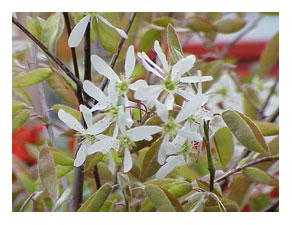Amelanchier oblongifolia. Rose Family.
A tall shrub or small tree found in low ground. Leaves. - Oblong, acutely pointed, finely toothed, mostly rounded at base. Flowers. - White, growing in racemes. Calyx. - Five-cleft. Corolla. - Of five rather long petals. Stamens. - Numerous, short. Pistils. - With five styles. Fruit. - Round, red, berry-like, sweet and edible, ripening in June.

The flowers of the serviceberry are typically white, although at times they can be pink, yellow or streaked with red. The fruit is excellent to eat raw, tasting somewhat like a blueberry, strongly accented by the almond-like flavor of the seeds. The wood is brown, hard, close-grained, and heavy. The heartwood is reddish-brown, and the sapwood is lighter in color.
Down in the boggy meadow in early March we can almost fancy that from beneath the solemn purple cowls of the skunk cabbage brotherhood comes the joyful chorus—
For lo, the winter is past!—
but we chilly mortals still find the wind so frosty and the woods so unpromising that we return shivering to the fireside and refuse to take up the glad strain till the feathery clusters of the shad bush droop from the pasture thicket. Then only are we ready to admit that
The flowers appear upon the earth,
The time of the singing of birds is come.
Even then, search the woods as we may, we shall hardly find thus early in April another shrub in blossom, unless it be the spicebush, whose tiny honey-yellow flowers escape all but the careful observer. The shadbush has been thus named because of its flowering at the season when shad ''run ; " Juneberry, because the shrub's crimson fruit surprises us by gleaming from the copses at the very beginning of summer; serviceberry, because of the use made by the Indians of this fruit, which they gathered in great quantities, and, after much crushing and pounding, utilized in a sort of cake.
